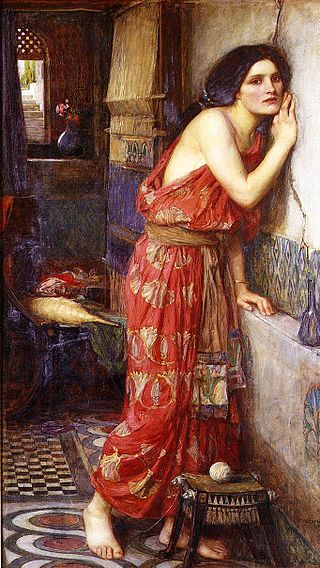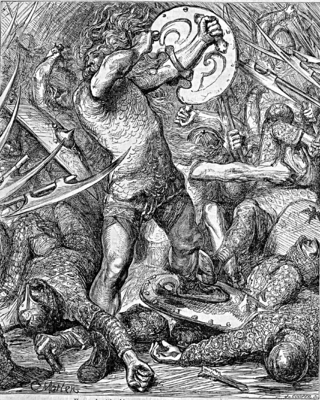Related Research Articles

Stephen, often referred to as Stephen of Blois, was King of England from 22 December 1135 to his death in 1154. He was Count of Boulogne jure uxoris from 1125 until 1147 and Duke of Normandy from 1135 until 1144. His reign was marked by the Anarchy, a civil war with his cousin and rival, the Empress Matilda, whose son, Henry II, succeeded Stephen as the first of the Angevin kings of England.

Pyramus and Thisbe are a pair of ill-fated lovers whose story forms part of Ovid's Metamorphoses. The story has since been retold by many authors.

Blois is a commune and the capital city of Loir-et-Cher department, in Centre-Val de Loire, France, on the banks of the lower Loire river between Orléans and Tours.

Hereward the Wake (c.1035 – c.1072) was an Anglo-Saxon nobleman and a leader of local resistance to the Norman Conquest of England. His base, when leading the rebellion against the Norman rulers, was the Isle of Ely in eastern England. According to legend he roamed the Fens, which nowadays covers parts of the modern counties of Cambridgeshire, Lincolnshire and Norfolk, leading popular opposition to William the Conqueror.

St Benet's Abbey was a medieval monastery of the Order of Saint Benedict, also known as St Benet's at Holme or Hulme. It was situated on the River Bure within the Broads in Norfolk, England. St Benet is a medieval English version of the name of St Benedict of Nursia, hailed as the founder of western monasticism. At the period of the Dissolution of the Monasteries the abbey's possessions were in effect seized by the crown and assigned to the diocese of Norwich. Though the monastery was supposed to continue as a community, within a few years at least the monks had dispersed. Today there remain only ruins.

Edmund the Martyr was king of East Anglia from about 855 until his death.

Augustin Thierry was a French historian. Although originally a follower of Henri de Saint-Simon, he later developed his own approach to history. A committed liberal, his approach to history often introduced a romantic interpretation, although he did engage in research of primary sources. He nevertheless was recognised as a significant historian of the evolution of communal governance.

Medieval architecture is architecture common in the Middle Ages, and includes religious, civil, and military buildings. Styles include pre-Romanesque, Romanesque, and Gothic. While most of the surviving medieval architecture is to be seen in churches and castles, examples of civic and domestic architecture can be found throughout Europe, in manor houses, town halls, almshouses, bridges, and residential houses.
The lais of Marie de France are a series of twelve short narrative Breton lais by the poet Marie de France. They are written in Anglo-Norman and were probably composed in the late 12th century, most likely between 1155-1170. The short, narrative poems generally focus on glorifying the concept of courtly love by the adventures of their main characters. Marie's lais are thought to form the basis for what would eventually become the genre known as the Breton lais. Despite her stature in Anglo-Norman literature and medieval French literature generally, little is known of Marie herself, but it is thought that she was born in France and wrote in England.

Henry of Blois, often known as Henry of Winchester, was Abbot of Glastonbury Abbey from 1126, and Bishop of Winchester from 1129 to his death. He was a younger son of Stephen Henry, Count of Blois by Adela of Normandy, daughter of William the Conqueror and Matilda of Flanders. Thus, he was a younger brother of Stephen, King of England, and a grandchild of William the Conqueror. Henry was also a major patron of the arts.
Anglo-Norman literature is literature composed in the Anglo-Norman language and developed during the period of 1066–1204, as the Duchy of Normandy and the Kingdom of England were united in the Anglo-Norman realm.
Partonopeus de Blois is a long poem in the chivalric romance genre written in Old French in the 1170s or 1180s. Its author is unknown, but some scholarly studies indicate Denis Pyramus.
The Song of Dermot and the Earl is an anonymous Anglo-Norman verse chronicle written in the early 13th century in England. It tells of the arrival of Richard de Clare (Strongbow) in Ireland in 1170, and of the subsequent arrival of Henry II of England. The poem mentions one Morice Regan, secretary to Dairmaid mac Murchadha, king of Leinster, who was eyewitness to the events and may have provided an account to the author.

Rabia Balkhi, also known as Rabia al-Quzdari was a 10th-century writer who composed poetry in Persian and Arabic. She is the first known female poet to write in Persian.

St Edmundsbury Cathedral is the cathedral for the Church of England's Diocese of St Edmundsbury and Ipswich. It is the seat of the Bishop of St Edmundsbury and Ipswich and is in Bury St Edmunds in Suffolk. Originating in the 11th century, it was rebuilt in the 12th and 16th centuries as a parish church and became a cathedral in 1914; it has been considerably enlarged in recent decades.
Anglo-Norman, also known as Anglo-Norman French, was a dialect of Old Norman French that was used in England and, to a lesser extent, elsewhere in Great Britain and Ireland during the Anglo-Norman period.
Geoffrey of Wells was a mid-12th-century English hagiographer and a canon of Wells Cathedral, whose De Infantia Sancti Edmundi, part of the burgeoning library of 12th-century legendaries concerning Saint Edmund, accounted the royal saint's childhood to have been full of adventure. He dedicated his "largely spurious account" to Ording, eighth abbot of Bury St. Edmunds, and spoke of the encouragement of another well-placed Anglo-Saxon, Prior Sihtric. The manuscript of Geoffrey's pious embroidery was among the manuscripts collected by the early 17th-century antiquary Robert Bruce Cotton, now conserved in the British Library in London.
Pyramus is a character in Greek mythology.
An equestrian seal is a type of seal used in the European Middle Ages, characterized by the depiction of the owner as a mounted warrior in full armour. Originating in the high medieval period, the type was frequently used throughout the 13th to 14th centuries. Continued use into the 15th and 16th centuries was mostly limited to high nobility, especially royalty, while lower nobility switched to the use of simple heraldic seals.
Hugh was a French knight and Benedictine monk, abbot of monasteries in England and France.
References
- JSTOR notes on Pyramus
- Anglo-Norman studies by Marjorie Chibnall
- Catholic Encyclopedia on Denis Pyramus